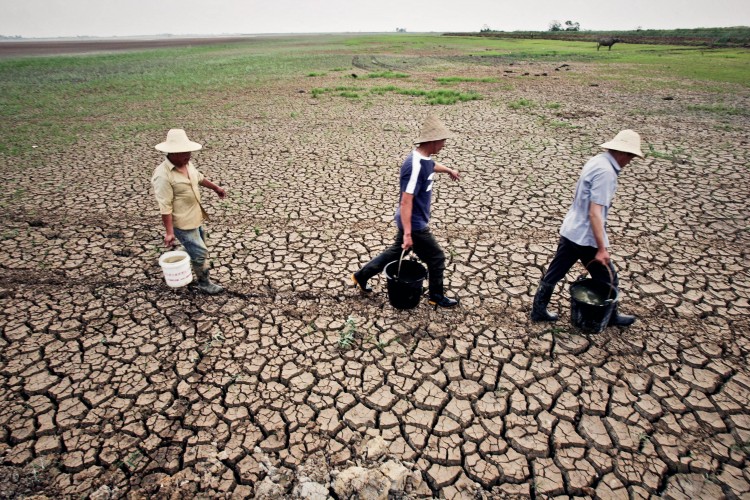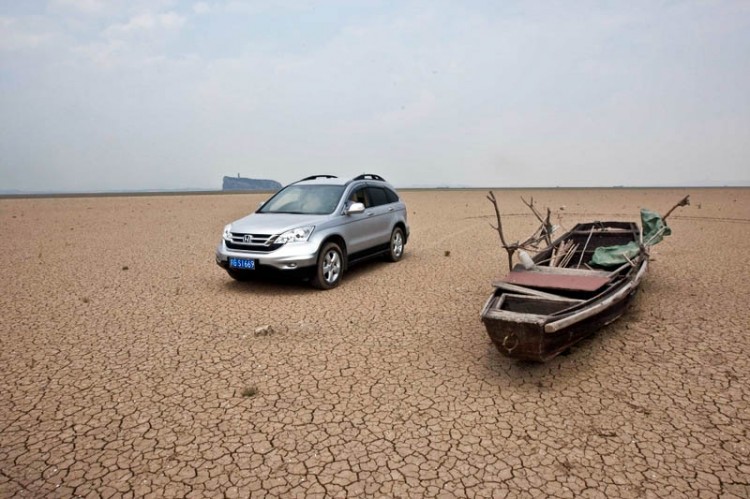An ongoing drought in central and eastern China not seen in 50 or 100 years has dried up many rivers. Downstream provinces near the Three Gorges Dam have been scourged, the Yangtze River is withering, and China’s largest freshwater lake is nearly dry, pushing the ecological system in a large area to the brink of calamity.
Human activities are also being badly impacted. Drinking and irrigation water is in short supply, rice crops are dying, and cargo vessels are stranded.
And the threat of extinction to one wildlife species highlights all those troubles.
Finless Porpoise
The Tian-e-Zhou Oxbow Nature Reserve, a wetland in the Yangtze Basin near Shishou city in China’s central Hubei Province, is the only sanctuary for the endangered finless porpoise.
During this year’s breeding season, which lasts from April to June, the worst drought in 50 years has caused water levels in most parts of the reserve to drop to less than 10 feet, and even as low as 6 feet in some places, severely threatening the survival of the finless porpoises, the Yangtze Daily reported on May 21.
The low water levels are not only restricting the porpoises, but also making them rather sad, according to Chinese media reports. One report recounted that when research staff at the reserve monitored one of the mammals’ health, a reporter took a photo of the animal with a tear coming from its eye.
Poyang Lake
Poyang Lake, China’s largest freshwater lake, is said to be experiencing the worst drought in 100 years, holding only one-tenth of last year’s water level. Some areas of the lake have completely dried up, with four-inch wide cracks. Cars are able to drive across the lakebed, China National Radio (CNR) reported on May 21.
Wang Qiaolong who worked in the Poyang Lake Natural Reserve for 28 years, told CNR that the drought has killed large number of aquatic plants, fish, and shell fish, which in turn threatens migratory birds.
Rice crops in the area are also in danger.
An employee of the Poyang County government told The Epoch Times that the disaster is very severe and all the reservoirs and lakes are almost dry.
“The Yangtze River is drying up and the Poyang Lake has long dried up. If ‘old grandpa Heaven’ doesn’t send rain, there will be no harvest at all. Jiangxi Province is an important grain producer for the country, but this year we’ve lost big time,” he said.
The 131 large- and mid-sized irrigation pump stations in the cities of Nanchang, Jiujiang, and Shangrao, Jiangxi Province, have not been pumping water as usual because of the low water level at Poyang Lake.
About 5,330,000 mu (878,000 acres) of early season rice in Jiangxi Province are affected. Of the mid-season rice, about 1,400,000 mu (231,000 acres) cannot be planted because there is no water in the rice fields, state media said on May 21.
In Hunan Province, another large rice producing area, 28 counties are under “heavy” drought and 12 counties under “severe” drought, according to other reports.
Hardest hit was Xinhua County, where 90 percent of the fields could not be planted.
In the Dongting Lake area—known as a land of plenty—much of the early season rice crops died this year due to the drought.
Read More...River Cargo
River Cargo
Commerce is also suffering due to the drought, and shipping on the Yangtze has become a problem.
In Shandong Province, as water levels dropped, over 1,300 canal and cargo boats have been stranded in the Zaozhuang section of the Grand Canal, which links Beijing to Hangzhou, New Tang Dynasty Television reported on May 24. Only 300 boats a day are allowed to pass through, and vessels weighing more than 1,500 tons have been turned away.
The same report also quoted a survey by the Hubei Agricultural Department saying the five-month drought has left over 300,000 people and nearly 100,000 livestock in the province short of drinking water.
Regime Response
On May 19, China’s State Department issued a “Three Gorges Dam Post Construction Plan,” admitting the Dam has negatively influenced the middle and lower reaches of the Yangtze River. On May 20, the regime decided to increase the amount of water released by the dam to 10,000 cubic meters per second in order to help relieve downstream drought conditions.
Admitting there are some problems with the dam indicates that the problems are so serious that the authorities cannot hide them anymore. Acknowledging this now will help some officials to escape punishment, hydraulic expert Wang Weiluo told The Epoch Times .
The Post Construction Plan is actually Hu Jintao’s and Wen Jiabao’s public announcement to distant themselves from the Deng Xiaoping and Li Peng era, when the decision to build the dam was made, according to former Xinhua News Agency senior reporter Dai Qing, in an interview with Hong Kong’s Apple Daily. In previous years Dai Qing conducted extensive research and wrote a book on the dam.
Dai regards the Three Gorges Dam a heavy burden, a national calamity, and the source of “countless disasters” for the Chinese people.
[email protected]









